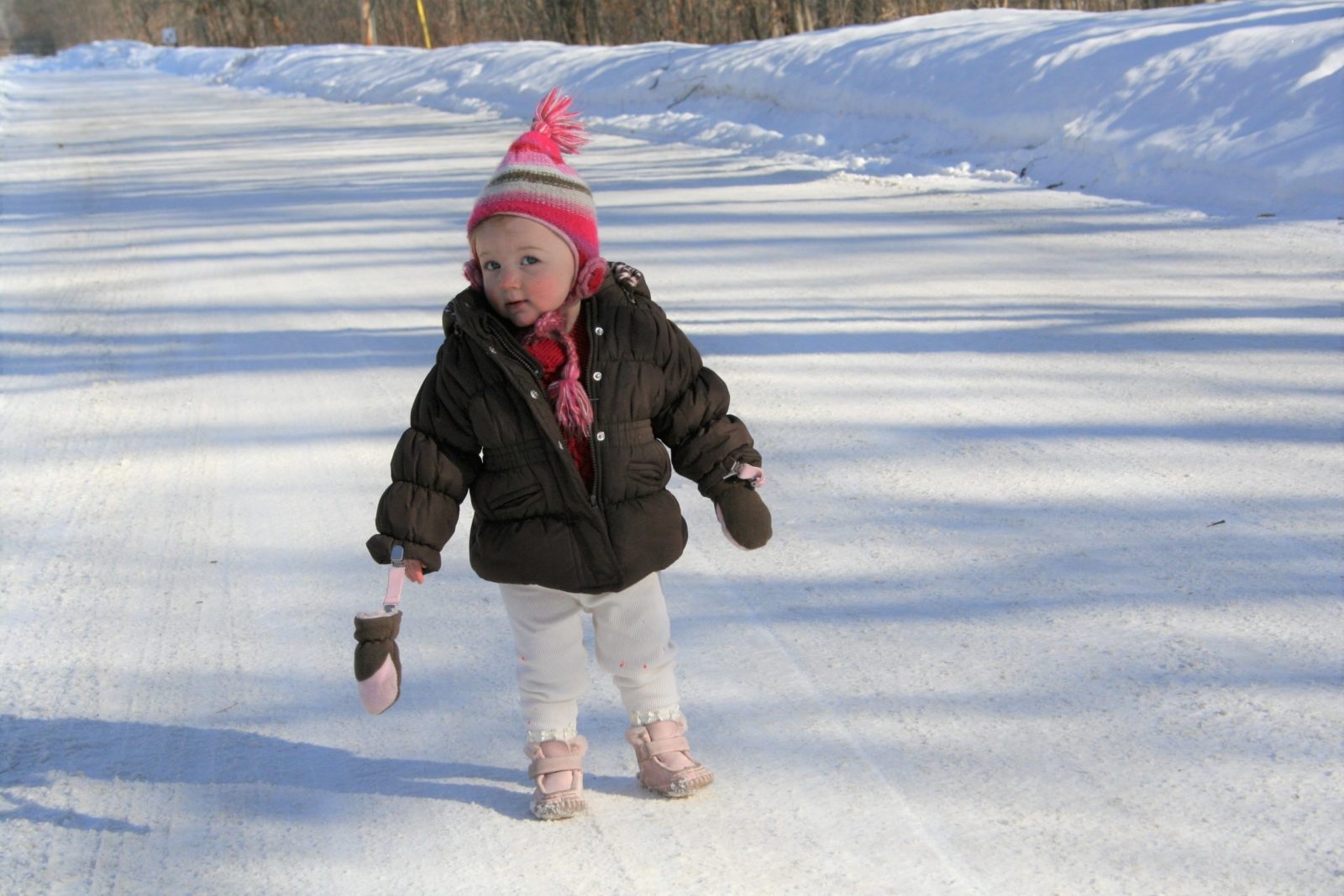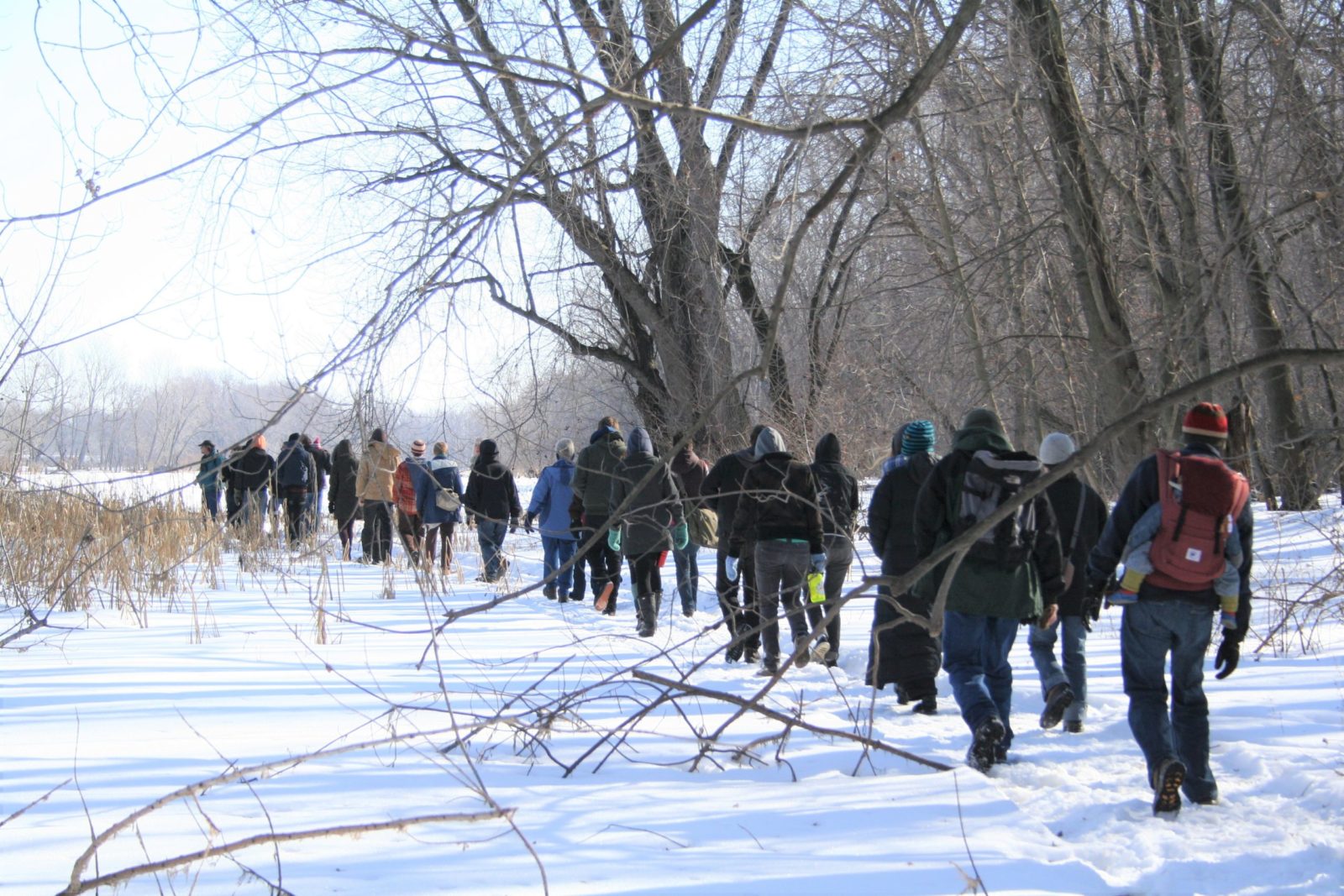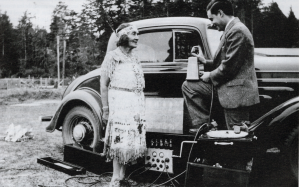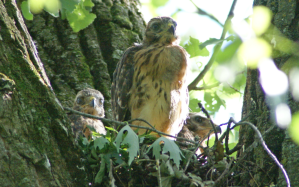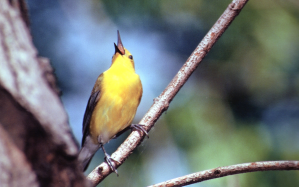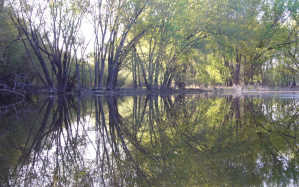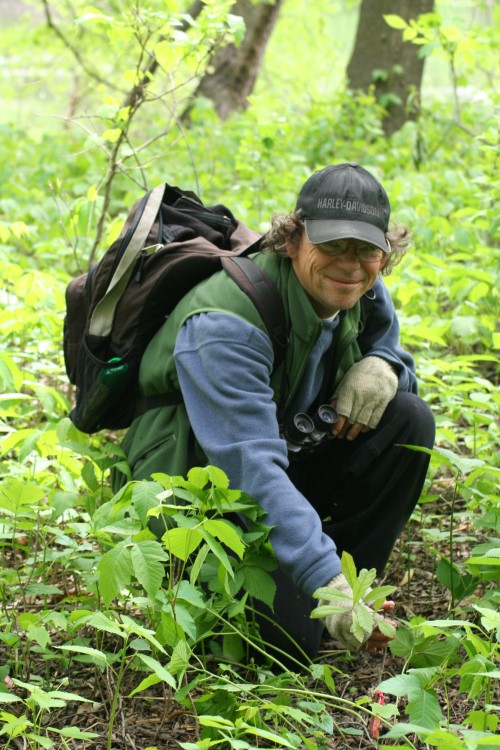FROZEN RIVER WALKS
Richie Swanson led nature walks through winter habitat at Aghaming Park and Preserve and wrote newspaper columns that advocated for the protection of Aghaming, 2008-2012. The Mississippi River Revival sponsored the efforts, which highlighted the research of the River Bird Blog conducted in 2007, and advocated for the protection of wetland habitat, the red-shouldered hawk and other wildlife at Aghaming. The critical habitat is now managed as the “Aghaming Unit” of the Upper Mississippi River National Wildlife and Fish Refuge. The Winona Bird Club, Winona County Green Party, Aghaming Park Committee, City of Winona, Wisconsin Department of Natural Resources and United States Fish and Wildlife Service assisted in the conservation success.
The newspaper columns and photos by Barbi Bell are archived below. The Mississippi River Revival is no longer an active organization.
FIRST ANNUAL FROZEN RIVER WALK 2008
(Copyright 2008 by Richie Swanson)
Mississippi River Revival, sponsor
About the time river birches turn green, a tiny yellow bird drops from her nest-stump, landing on a dead log at Aghaming Park and Preserve. The female prothonotary warbler flutters strenuously backward, pecking and tugging moss, filling her bill for her nest-cup. Sometimes a house wren slips into her nest-hole first. Look out! The male prothonotary comes dive-bombing, calling sharply, and the two species pop from the stump-hole, streaking through foliage, singing against each other, both needing a cavity for broods.
If you join Mississippi River Revival’s Frozen River Walk this Sunday, you’ll visit nest-stumps side-by-side, one full of wrens’ sticks, the other a prothonotary’s nest-site. We’ll meet 1:00 PM, Wisconsin side of the Wagon Bridge, and walk 90 minutes through shin-deep snow on current-free ice at places I call Osprey Marsh and Prothonotary Trail. We’ll seek signs of wildlife, especially nest remnants, giving kids first chance to discover and ask questions. We’ll also quiet ourselves, looking high into trees, so bring binoculars.
Prothonotary warblers symbolize how desperately migratory birds need Aghaming and other protected places here. Prothonotaries winter in mangrove forests 60-90% gone from Central and South America. They breed in mature floodplain forests 90% gone from the Midwest. Twenty percent of their global population breeds on the Lower Miss, and much of the rest migrates our way.
Aghaming easily supports 100 breeding pairs per year, I think—good news to counter bad. The Breeding Bird Survey at Patuxent Wildlife Research Center indicates prothonotaries have declined 39% since 1966. Other warblers using Aghaming decreased even more across their breeding ranges—the Canada, 55%; golden-winged, 61%; bay-breasted, 62%; cerulean, 80%. But everyone who attended a meeting about Aghaming the last few years, shared a viewpoint, looked up research or attended a previous walk can know they helped keep species on Earth, including mink, otters, beavers and Blanding’s and other turtles.
“Protect the remaining large, intact ecosystems,” says Birder’s Conservation Handbook, Jeffrey Wells, Princeton University Press. The city’s done so, wisely recognizing Aghaming’s legal wetland status, installing gates and signs, keeping motorized vehicles out of sensitive habitat March-November, allowing ice-fishing access December-February. Red-shouldered hawks used all of Latsch’s gift behind gates this past breeding season. We’ll walk where the state-threatened species chased and lambasted owls and Cooper’s hawks, apparently protecting young from predators.
We’ll pause beneath the courtship limb of the yellow-billed cuckoo, where the cuckoo’s “knocker-call” knocks, a male places a twig in a female’s bill, and fledglings appear weeks later. The yellow-billed unfortunately lost a petition for Endangered Species Act protection in 1998. The cuckoo’s already gone from Oregon, Washington and British Columbia, due partly to losses of shrubs beside creeks and rivers, also a Midwestern problem. Aghaming provided abundant cuckoo territories last breeding season.
The minute we walk down to a slough Sunday, we’ll tread migratory feeding grounds of America’s most swiftly declining bird and the river’s most seriously decreasing duck. Rusty blackbirds declined 99% since 1966, says BBS data. The species concentrates on the Lower Miss during winter. Thousands swarmed Aghaming last spring, finding caddis fly larvae and other food on their way to nest-sites in boreal wetlands, where global warming appears to change water levels and chemistry and food for young, insect populations.
Climate change may also reduce insect prey for lesser scaup—bluebills—on their nesting grounds in western Canadian forests. Bluebills feed at Osprey Marsh and Sam Gordy’s every spring. Their continental population dropped from about seven to 3.5 million since 1983, according to Minnesota Conservation Volunteer. Some scientists think female bluebills fail to find enough river-shrimp and other food during migration, arrive at breeding grounds so underweight they fail to reproduce. Others think bluebills may ingest too much selenium, a by-product of copper smelting and other industries, when eating Zebra mussels, and high levels may impair egg-laying.
We’ll see where tree swallows and catbirds lay eggs, least bitterns weave fishing platforms, yellow-headed blackbirds defend harems, and buttonbush hides hooded merganser chicks. We’ll be wildlife Patriots and stand where new, unseemly, Giant power towers might cross the flyway, cutting into swamp white oaks.
The CapX utilities-commission has proposed 345-kV towers up to 175-feet tall, possibly along the river to La Crosse. The lines would rise amid North America’s most crucial bird migration corridor. The Upper Miss supports 40% of the continent’s waterfowl, nearly 300 bird species in all, and 185 Neotropical migrants, birds breeding on this continent but wintering south of the Tropic of Cancer. A 2005 Forest Service study estimated electrical transmission lines kill 130 million birds per year. BBS data indicates 48 Neotropical species have declined significantly since 1966. Three-quarters of these threatened species use the Upper Miss, so we’ll consider impacts at Aghaming, including red-shoulder nests.
A campfire, cookies, hot cider commence at 2:30 PM, Latsch Island Beach. Dress warmly!
This column appeared in the Winona Daily News, January 24, 2008.
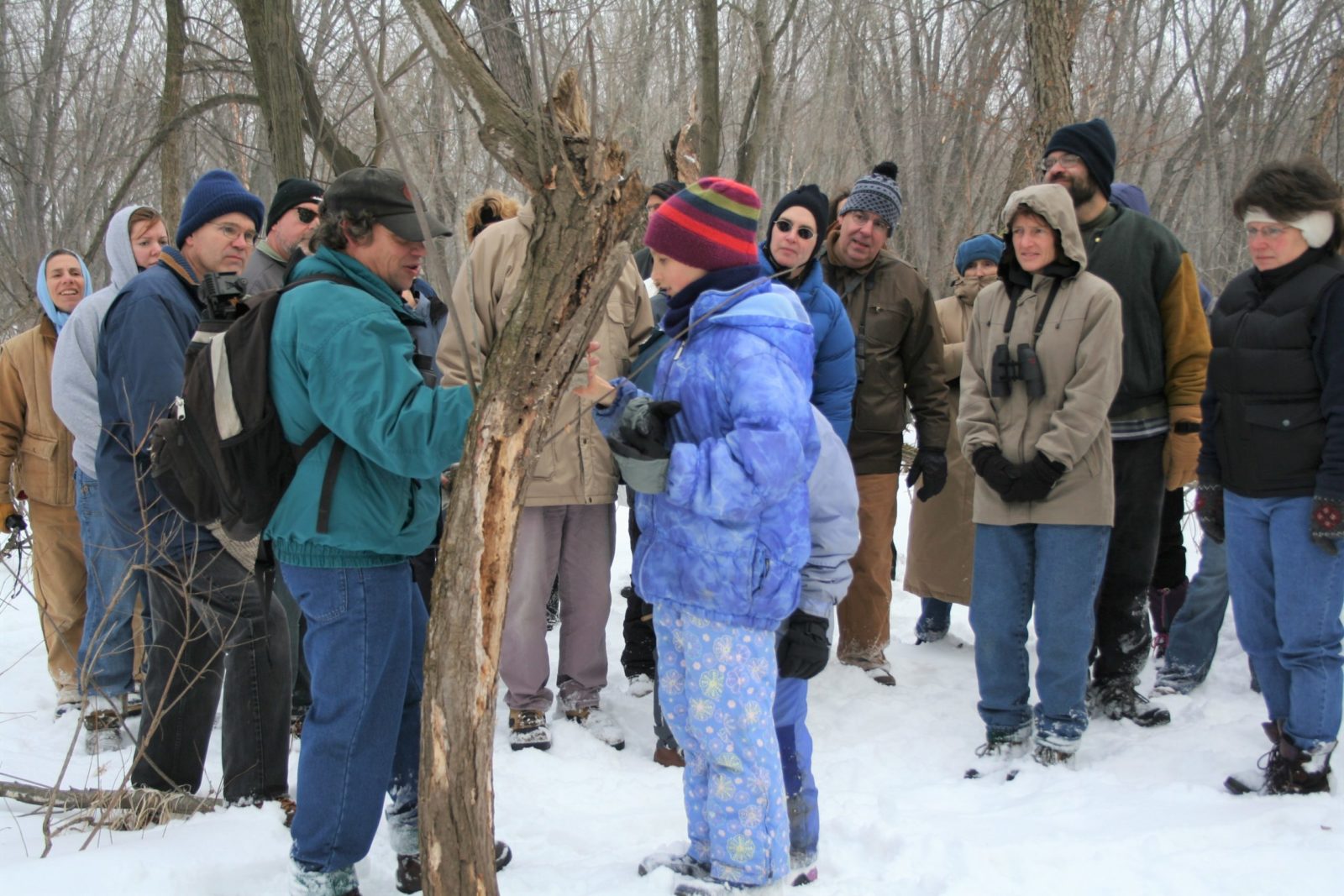
THIRD ANNUAL FROZEN RIVER WALK 2010
Lesser Scaup and River Sedimentation
(Copyright 2010 by Richie Swanson)
Mississippi River Revival, sponsor
Remember when a catbird sang “a rapture of enjoyment” on Jackson Island, causing Tom to wake the other boy-pirates to go a-fishing? When Jim told Huck to bait a catfish “six foot two inches long” with a skinned rabbit? Well, the Mississippi’s birds and wildlife sing secrets much muddier these days, and I hope to share some with you at the Frozen River Walk this Saturday at Aghaming Park and Preserve.
We’ll meet at the Wisconsin end of the Wagon Bridge, one o’clock. We may follow fox tracks to urine marks which may reveal secrets about food caches. We’ll visit a marsh where eagles, falcons and ospreys rebound from near-extinction. We’ll visit specialized nesting sites amid threatened woods and readily discuss the proposal for the Upper Mississippi River National Wildlife and Fish Refuge to help manage Aghaming. We’ll also gaze at bluffs and consider how nitrates and other sediments flow to the “Zone of Hypoxia” at the river’s mouth and how a duck and blackbird raise critical questions about Planet Earth.
Numbers of the duck called the lesser scaup or “bluebill” are about 50% less since the late 1970s, said Dr. Michael Anteau, Northern Prairie Wildlife Research Center. Bluebills seem intricately linked to the Mississippi. “Up to 86% of the scaup population winters in states bordering the Gulf of Mexico and potentially migrates along the Mississippi River valley,” Anteau wrote recently.
Bluebills forage in gulf waters and coastal marshes during winter, eating snails, clams and mussels, which hypoxia kills and diminishes. Though they stop at Aghaming during spring, they concentrate most densely on the river on Pool 19 near Hamilton, Illinois, where they find abundant fingernail clams and mussels. But they specialize on freshwater shrimp in the upper Midwest and find insufficient food as they continue north, according to Anteau. Hens have been found with 50% fewer fat reserves in Iowa and southern Minnesota than at Pool 19. Similar losses have been recorded in northwestern Minnesota.
Bluebills feed in wetlands where farm chemicals deplete freshwater shrimp. While flying, they may mistake turbid water caused by runoff for a visual cue for shrimp, says Anteau. They land, search, spend valuable energy.
Hens may arrive at nesting grounds such as Slave Lake in Alberta and Yellowknife in the Northwest Territories without enough fat stores to develop ovaries or eggs. They may die migrating or reach nest sites too late to raise chicks. They nest on floating mats of vegetation or shores of wetlands which global warming may dry up, and which logging, mining and other development usurps. As permafrost melts in the far north, water chemistry changes, and so may insect hatches chicks depend upon.
While bluebills feed at Aghaming, rusty blackbirds put on a frantically-paced show at flood pools, tossing leaves, probing mud, hopping onto floating logs, hammering into dead wood. Scientists estimate the species’ population at less than two million, down 99% since 1966. Hundreds—sometimes thousands—swarm Aghaming late March to mid-April.
Rusties rely much more upon aquatic insects, not corn and grain, than other blackbirds. They breed all across the northern continent in wooded wetlands which suffer similar losses and degradations as scaup habitat. The bottomland forests along the lower Mississippi supports the species’ largest winter concentrations.
Scientists have found female rusties more reliant upon bottomland forests than males, and in less healthy conditions. This made me wonder if female rusties and other migratory birds find enough fat stores on the upper Mississippi, especially in marshes and floodplain forests like Aghaming’s. Or if sedimentation contributes to a shortage?
“The stuff you’re talking about is really exciting and has been barely studied in the upper Mississippi River,” said Dr. Bill Richardson, an aquatic ecologist at USGS Upper Midwest Environmental Sciences Center, working with collaborators from USGS and Dr. Roger Haro at the River Studies Center, U-W La Crosse.
Scientists at USGS-UMESC suspect birds in the floodplain acquire much of their fat stores from insects and other invertebrates produced in the river, said Richardson. Fat reserves in shrimp in Pool 8 have been measured and seem sufficient for scaup feeding there. But much more work is in process. Scientists suspect the Asian carp, an exotic species, eats and holds enough of the river’s fat sources to possibly have negative impacts on fat available in the food chain. They also know sedimentation has negative impacts on insects in other aquatic systems, but still need data for the upper Mississippi.
If you walk the frozen river, you can sense how the thaw pours down and bug-hungry birds hurry upriver during spring. Everyone can help appreciate Aghaming’s habitat, especially kids with questions. We’ll host a campfire on Latsch Island Beach afterward. The walk is free, thanks to Mississippi River Revival, a strong voice for the Mississippi since 1981. Bring binoculars, boots, cookies!
This column appeared in the Winona Daily News, February 2010.
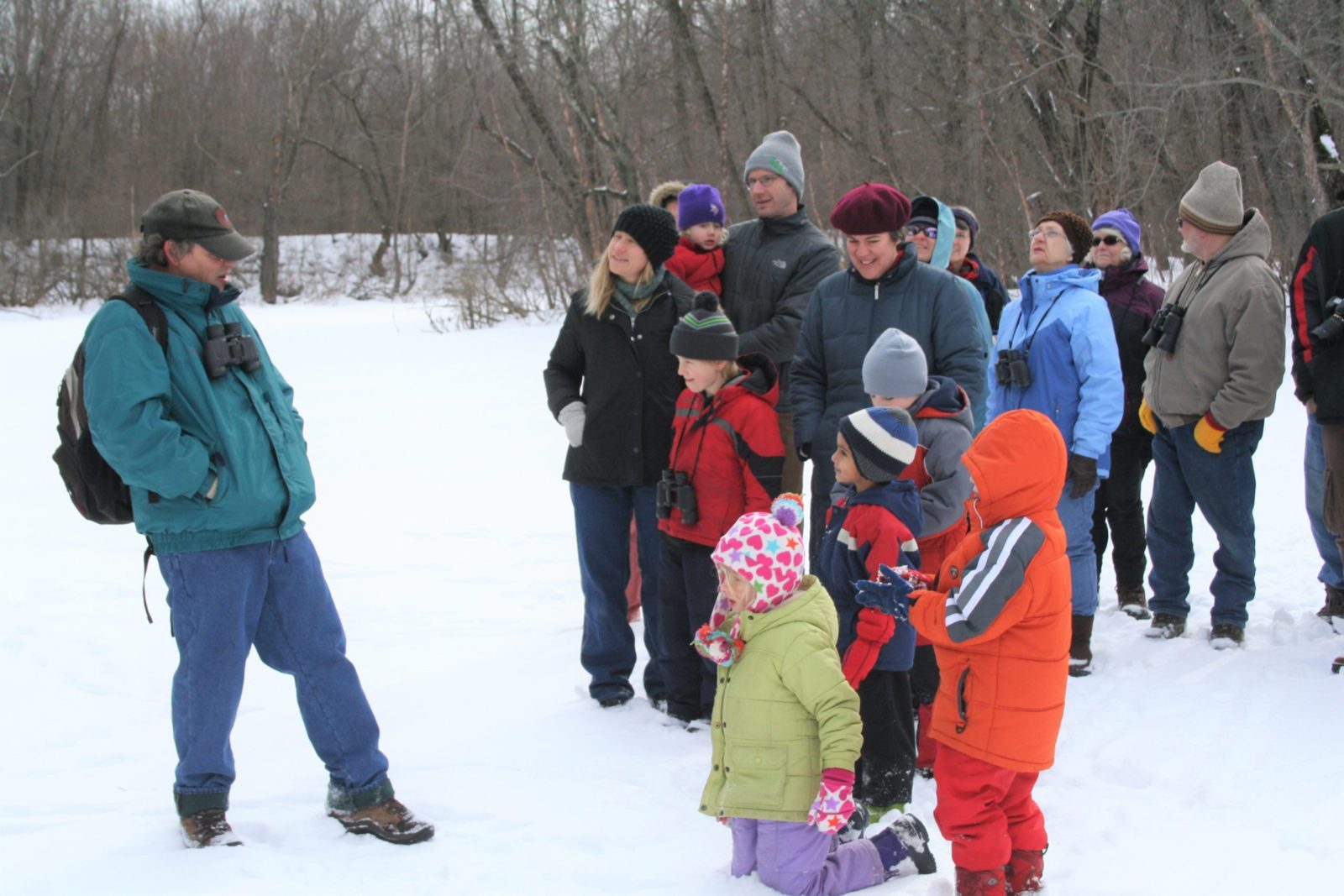
FOURTH ANNUAL FROZEN RIVER WALK 2011
(Copyright 2011 by Richie Swanson)
I felt uplifted about conservation and Aghaming Park and Preserve during last April’s Passenger Pigeon Walk. Participants saw bluebills, a declining duck who winters in the Gulf of Mexico and desperately needs cleaner food chains there and on the Mississippi. Ospreys displayed on a nest, continuing to rebound from near-extinction. Three days later, red-shouldered hawks were confirmed breeding deep in Aghaming where off-road vehicles had overrun the floodplain forest the previous year.
People had worked hard together, insuring vehicle-free habitat for the state-threatened hawk in 2010. Now a mama red-shoulder hunkered down in a cottonwood-crotch, incubating secretly and silently, nearly invisibly, just as her needs demanded. But twelve hours later the Deepwater Horizon well exploded, and the world changed drastically for the river’s migratory birds.
By the time red-shoulder chicks poked fuzzy-white heads above the nest-rim, oil had spewed for three weeks. It continued four weeks later as three young hawks stood with mottled breasts, flexing wings, itching to fly. Oil continued to spill in the gulf six weeks after the red-shoulder nest was vacated, while fledglings of great blue herons and other gulf-bound species stored calories to fly south.
Mississippi River Revival hosts the fourth annual Frozen River Walk this Saturday, February 5, 1:00 to 2:30 P.M. Please, bring kids and cookies and wear footwear for cold-wet snow (no sneakers). We’ll meet at the Wisconsin end of the Wagon Bridge and explore Osprey Marsh, where I’ll identify vegetation and niches crucial for bird species who must overcome the BP disaster.
Here, red-shoulders hovered in courtship and caught frogs for nestlings. Here, white pelicans gathered in an Aghaming slough, schooling fish. Here, ospreys nested for the first time following the ban on DDT. Here, green herons crouched at water’s edge, and I tried to see them drop bark as fish lures. All these species have been found dead and oiled in gulf areas, according to wildlife collection data compiled by U.S. Fish and Wildlife.
Here, state-threatened great egrets congregated at Aghaming, stabbing frogs and shiners, grunting like pterodactyls. Here, a least bittern wove a fishing platform out of bulrush. Here, herring gulls pumped heads over thawing ice, yelping over rights to dead bullheads. Here, common loons and state-endangered Caspian and Forster’s terns fished during April. These bird species were also found dead and oiled.
Here, yellow-billed cuckoos sang “knocker calls,” passing twigs during mating rituals. Here, a blue-winged teal sat on a grassy nest, trying to avoid fox predation. Here, pied-billed grebes crooned other-worldly croaks in ghostly fog. Here, black-crowned night herons crept through flooded buttonbush, and black terns flew towering courtship flights, delivering fish to prospective mates. These species were also found dead and oiled.
Yellow-crowned night herons once bred at Aghaming. Wisconsin lists the species as endangered and knows of only six breeding populations in the entire state, according to a DNR fact sheet. The species apparently relies upon crayfish here and crabs in tide pools, mudflats and other coastal environs down south, habitats recently oiled.
No one really knows how many yellow-crowns and other birds Deepwater Horizon has killed or impaired. I hold my breath for ducks. Nearly thirteen million ducks and geese use the gulf some winters, says Ducks Unlimited. About forty percent of North America’s waterfowl use the upper Mississippi, says USFWS. Some breed here. Millions more migrate to boreal wetlands which apparently are drying up, changing biologically due to global warming and other human influences.
I won’t dwell on oil during the walk. We’ll seek signs of otter, fox, mink and beaver, and haunts of snapping, soft-shelled and other turtles. We’ll pass a shrub-line where brown thrashers might sing more than a thousand distinct song-phrases during a spring morning–but, hey, look at the bluff upriver! A few years ago Peregrine falcons returned to a natural nest site there. The species migrates to the gulf and may eat a duck in wetlands still contaminated with oil in 2030. Millions of other raptors, songbirds, terns, gulls and shorebirds attempt to cross the gulf or find food along its perimeter while migrating to South America each year.
I am reminded of the Derek Jeter ad that describes his parents teaching him positive values, faithfully practicing groundballs in a vacant city lot. “Funny, all that time I thought they were talking about baseball,” he says. If you’re working for conservation around Winona, you’re in for a similar surprise. You might think you save bluffs, water quality, fishing sites and beloved views along our beautiful Mississippi. But you’re also helping mitigate the ugliest oil spill in history, nearly 500 million barrels. You’re helping protect the upper river where species reduced by oil can breed and migrate successfully, giving birds a fighting chance to sustain populations.
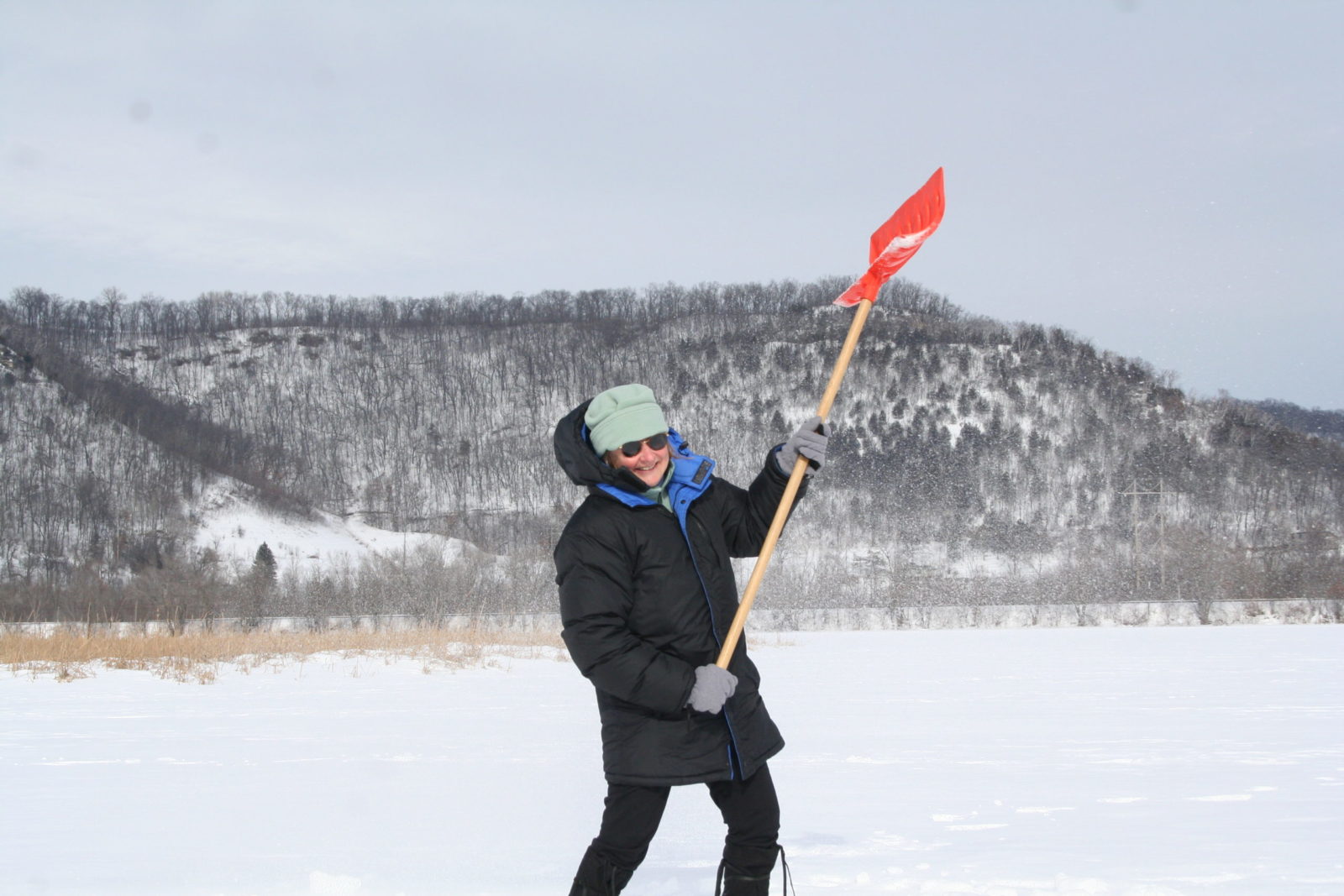
FIFTH ANNUAL FROZEN RIVER WALK 2012
(Copyright 2012 by Richie Swanson)
If you stargaze from Aghaming Park and Preserve, you can see Orion and Pleiades above the Minnesota bluffs, then Triangulum and Aries farther west. Suddenly you’re viewing the Zodiac, the sun’s path—and an ancient Lakota story, a constellation named for red osier dogwood, which grows in Winona’s river-bottoms.
We’ll visit red osier bushes and secret haunts of wildlife during the fifth annual Frozen River Walk, Saturday 1-2:30 p.m., offered free by Mississippi River Revival. Though we won’t view constellations, we’ll walk one ½ mile roundtrip, celebrating nature. Please, wear winter boots, warm clothing. Bring kids, binoculars, cookies to share.
We’ll visit wildlife niches destined to wake soon—crows’ nests, warbler holes, turtle logs, Cuckoo Slough, signs of fox, beaver, mink. We’ll reflect on red osier. Every year the Lakota smoke its inner bark as tobacco, honoring the red osier constellation during the end of winter, says Ronald Goodman in Lakota Star Knowledge.
This is the part I love. The sky myth connects to real wisdom on Earth. As the sun travels the sky the first morning of spring, the Big Dipper carries a coal and lights a sacred pipe (the red osier constellation), says Goodman. The fire of life gets renewed. The Lakota stop harvesting red osier. They leave it alone, allowing new life to grow.
We’ll walk the frog-hunting grounds of red-shouldered hawks, a species benefiting from red osier wisdom. Red-shoulders have declined about 90% since European settlement. They nest nearly exclusively in floodplain forests. A few years ago, motorized vehicles tore through Aghaming’s wetland woods every season, crushing vegetation, sometimes evicting red-shoulders. Now barriers go up March 1. The city of Winona controls traffic while red-shoulders regenerate.
We’ll walk to an 80-foot power pole which also evokes red osier wisdom. A few decades ago, DDT nearly exterminated ospreys, virtually eliminating the river’s population. The U.S. banned DDT. Ospreys resumed breeding on the river, and this pole supported their first nest back at Aghaming.
We’ll envision new power towers proposed by CAPX2020, the Hampton-Rochester-La Crosse route. We’ll consider Minnesota Environmental Impact Statement for the route, especially the proposed power line crossing from Kellogg to Alma. The Frozen Walk will keep moving, seeking wildlife’s secrets. But Minnesotans should know the Minnesota EIS endangers the Mississippi River Migration Corridor, failing a comprehensive knowledge of birdlife.
Though 40% of the continent’s waterfowl use the flyway, the EIS recommends towers 199 and 280-feet tall and three towering bands of lines stretched across airspace used by ducks and swans when fleeing from hunters to hunt-free habitat, e.g. Weaver Bottoms, Rieck’s Lake, Big Lake.
In one section the EIS claims the Mississippi Flyway “passes over” the CAPX2020 crossing. In another it claims to mitigate impact by spanning lines above habitat, ignoring airspace as part of migratory habitat. It also assumes the narrowest crossing safest for birds, ignoring that the landscape creates a bottleneck which may concentrate bird collisions with towers and lines.
The EIS claims “the effect of transmission lines on avian species are negligible beyond one mile.” But the lines will carry coal-generated electricity, increasing global warming that dries up wetlands in Alaska and the Yukon, used as breeding grounds by river migrants such as lesser scaup and rusty blackbirds.
The EIS relies upon a 1994 citation of the Avian Power Line Interaction Committee. Subsequent APLIC citations and USFWS power line guidelines exclude the one-mile suggestion. A 2008 study by California Energy Commission says, “Researchers do not know how far birds will fall from a power line following a collision.”
We’ll gaze up at bird flight diverters on wires, which the EIS claims mitigates collisions. The CEC study has doubts. “Collisions with transmission and distribution lines remains poorly understood,” it says. “Behavioral reactions to power line diverters are relatively unknown for most species, and may not be consistent between species.”
Forest Service reports estimate power-line collisions kill 130-175 million birds per year in the U.S., perhaps millions more. The EIS doesn’t reference the reports. It claims the impact on the flyway’s avian species “are not anticipated to be significant at a population level.” It looks for species of concern at the Kellogg-Alma crossing and doesn’t even find American white pelicans.
CAPX2020 and its Minnesota’s EIS lack red osier wisdom. They classify species and habitats, relating to wildlife as bureaucratic acronyms inside electronic files, creating a shell game of engineering options that under-emphasizes that dams, unnatural flow, pollution and exotic species already marginalize the flyway so much that the river no longer creates its own islands. Real breathing birds need better habitat, not new-gigantic obstructions in the middle of a corridor used by 300 species.
If you love nature, give the grid a break. Walk the Red Osier Trail Saturday.
